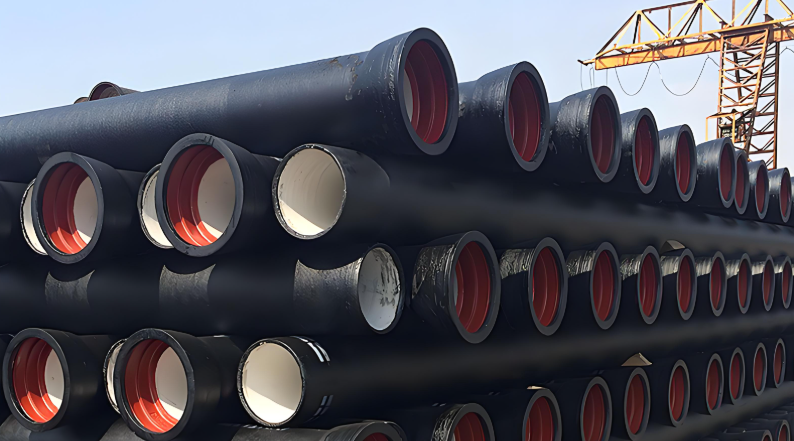When selecting piping materials for water supply, drainage, or industrial applications, engineers and project managers often debate between ductile iron pipes (DIP) and cast iron pipes (CIP). While both share historical roots, their material properties, performance, and modern applications differ significantly. This article provides a detailed technical analysis, supported by international standards and data, to guide decision-making.

1. Material Composition & Manufacturing
| Parameter | Ductile Iron Pipe (DIP) | Cast Iron Pipe (CIP) |
|---|---|---|
| Primary Alloy | Iron + Carbon + Silicon + Magnesium (for nodular graphite formation) | Iron + Carbon + Silicon (flake graphite) |
| Graphite Structure | Spheroidal (nodular) graphite (ISO 1083) | Flake graphite (ASTM A48) |
| Production Process | Centrifugal casting + Annealing | Static sand casting |
Key Insight:
The addition of magnesium during DIP manufacturing transforms brittle flake graphite into nodular graphite, enhancing ductility and tensile strength (ISO 1083:2018). CIP retains flake graphite, limiting its mechanical flexibility.
2. Mechanical Properties
| Property | Ductile Iron Pipe | Cast Iron Pipe |
|---|---|---|
| Tensile Strength | 420-600 MPa (EN 545:2010) | 150-300 MPa (BS EN 877:2017) |
| Elongation at Break | 10-25% | <1% |
| Impact Resistance | High (suitable for seismic zones) | Low (prone to brittle fracture) |
| Pressure Rating | PN10-PN40 (ISO 2531) | PN6-PN16 (EN 877) |
Authority Reference:
According to AWWA C151/A21.51, ductile iron pipes withstand surge pressures up to 2.5× working pressure, while CIP is restricted to 1.5× due to brittleness.
3. Corrosion Resistance & Lifespan
| Factor | Ductile Iron Pipe | Cast Iron Pipe |
|---|---|---|
| Standard Coatings | Zinc + epoxy (ISO 8179-1) | Coal-tar enamel (historic) |
| Cathodic Protection | Compatible (AS 2832.2) | Limited compatibility |
| Expected Lifespan | 100+ years (with proper coating) | 50-75 years (subject to corrosion) |
Case Study:
A 2021 study by the Ductile Iron Pipe Research Association (DIPRA) showed DIP with cement-mortar lining reduced tuberculation by 90% compared to unlined CIP in aggressive soils.
4. Application Scenarios
| Application | Ductile Iron Pipe | Cast Iron Pipe |
|---|---|---|
| Water Transmission | Preferred for high-pressure mains (ISO 2531) | Limited to low-pressure distribution |
| Sewer Systems | Widely used (resists ground movement) | Historical use; replaced by PVC/HDPE |
| Industrial Use | Chemical plants, mining (AS/NZS 2280) | Rarely used post-1980s |
Regional Standards:
-
USA: AWWA C150 (DIP) vs. AWWA C101 (CIP)
-
EU: EN 545 (DIP) vs. EN 877 (CIP)
-
Asia: GB/T 13295 (China DIP) vs. JIS G 5526 (Japan CIP)
5. Cost & Sustainability
| Aspect | Ductile Iron Pipe | Cast Iron Pipe |
|---|---|---|
| Initial Cost | Higher (due to alloy additives) | Lower (simpler production) |
| Lifecycle Cost | Lower (minimal maintenance, long lifespan) | Higher (frequent repairs/replacement) |
| Recyclability | 95% recyclable (ISO 14021) | 85-90% recyclable |
Sustainability Note:
DIP’s longevity aligns with UN SDG 6 (Clean Water) by reducing infrastructure replacement frequency.
6. Global Market Trends
-
DIP Dominance: 80% of new water mains in North America use DIP (DIPRA 2023).
-
CIP Decline: EU’s EN 877 restricts CIP to renovation projects due to environmental concerns.
Conclusion: Which to Choose?
-
Opt for DIP if:
-
High pressure/impact resistance is critical (e.g., earthquake zones).
-
Long-term ROI and sustainability are priorities.
-
-
Consider CIP only for:
-
Heritage restoration projects (e.g., Victorian-era drainage).
-
